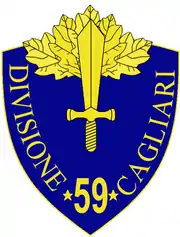59th Infantry Division Cagliari
The 59th Infantry Division Cagliari was a mountain infantry division of the Italian Army during World War II. It was formed 5 April 1939 in Vercelli and dissolved 8 September 1943 in southern Peloponnese. Garrisoned in Vercelli, the division was made up almost entirely of men from northern Piedmont, especially from Vercelli and Ivrea.[1] The only difference between line infantry divisions and mountain infantry divisions was that the latter's artillery was carried by pack mules instead of the standard horse-drawn carriages. Italy's real mountain warfare divisions were the six alpine divisions manned by the "Alpini" mountain troops.
| 59th Infantry Division Cagliari | |
|---|---|
 59th Infantry Division Cagliari Insignia | |
| Active | 1939–1943 |
| Country | Kingdom of Italy |
| Branch | Royal Italian Army |
| Type | Infantry |
| Size | Division |
| Garrison/HQ | Vercelli |
| Nickname(s) | Cagliari |
| Engagements | World War II Italian invasion of France Greco-Italian War |
| Commanders | |
| Notable commanders | General Antonio Scuero |
| Insignia | |
| Identification symbol |  |
| Identification symbol | Cagliari Division collar insignia |
History
As part of the Italian I Corps, the Cagliari participated in the Italian invasion of France in June 1940. Initially (10 June 1940) staying on the border at the Mont Cenis-Monte Niblè-Rocciamelone line, the division have moved across border 15 June 1940, capturing Dents d'Ambin, Sommet de la Nunda, Pas de la Beccia and Col de Sollières around Mont Cenis lake by 17 June 1940. On 21 June 1940 it reached the Arc river valley and started advancing to Bramans and Le Planey (on Ruisseau d'Étache stream), capturing both on 23 June 1940. Immediately attack was initiated to Val d'Ambin with the goal of Modane, but the Franco-Italian Armistice signed 24 June 1940 has stopped the Cagliary division short of this goal. The division remained in the Arc valley until the end of September, when it returned home to Italy.
On 21 January 1941, the orders were received to move to Albania. The Cagliari division completed its transfer to Berat on 31 January 1941, joining the Italian VIII Corps for the ongoing Greco-Italian War. First contact with the Greek forces was made on 8 February 1941 near Berat, with the clashes at Mali i Tërpanit and Paraspuar following soon. On 12 February 1941 the front had stabilised from Qafa e Bubësit to positions in valleys of Osum and Tomorrica rivers. On 11 March 1941, as part of the Italian Spring Offensive, after prolonged period of defence, the Cagliari division commenced attacks on Bubës, capturing it on 13 March 1941, but was unsuccessful in the assaults on Monastery Hill (Height 731) a few kilometers south during 14–19 March 1941. As a result of Greek units disengaging after the start of the German invasion of Greece on 6 April 1941, the Cagliari division advanced to the ridge overlooking Këlcyrë Gorge from north on 15 April 1941, overcoming some Greek rearguard resistance. On 18 April 1941 it continued pursuit to Përmet, and reached the pre-war border stream of Perati on 20 April 1941, where some Greek rearguard once more tried to make a stand. After the end of active fighting, it was used as occupation force in Kalpaki. In June 1941, the division was transferred to the southern Peloponnese. Main garrisons were established in Tripoli, Kalamata and Sparta, performing mopping-up and anti-partisan duties. The division disintegrated following announcement of the Armistice of Cassibile on 8 September 1943.
Orders of battle
Order of battle (1940–1943)
- 63. Cagliari Infantry Regiment
- 64. Cagliari Infantry Regiment
- 59. Artillery Regiment
- 28. CCNN Legion (Blackshirts)
- 28 CCNN battalion "Randaccio"
- 59. Mortar Battalion (da 81)
- 591a Anti-Tank Company (47/32)
- 59a Mixed telegraph/radio Signal Company
- 15a Pioneer Company [nb 1][3]
- 29. Carabinieri detachment
Order of battle (8 September 1943)
- 63. Cagliari Infantry Regiment
- 64. Cagliari Infantry Regiment
- 363 Cagliari Infantry Regiment
- 28 CCNN battalion "Randaccio"
- 59. Artillery Regiment
- 53a Machine gun company
- 15a Specialist engineer company
- 59. Mixed telegraph/radio signals company
- 68. Photoelectric signals company
- 8. Lancieri di Firenze
- 8. Artillery battalion
- 48. Artillery battalion
- 93. Artillery battalion
- 113. Artillery battalion
- 187. Artillery battalion
- 188. Artillery battalion
- 57. Anti-aircraft battery
- 2. Engineer battalion (2 companies)
- 215a Maintenance company
- 3. Battalion Guardia di Finanza
Notes
- Footnotes
- An Italian infantry division normally consisted of two infantry regiments (three battalions each), an artillery regiment, a mortar battalion (two companies) and an anti-tank company. A Blackshirt legion of two battalions was also sometimes attached. Each division had only about 7,000 men, The infantry and artillery regiments contained 1,650 men; the Blackshirt legion 1,200. Each company consisted of 150 men.[2]
- Citations
- http://www.regioesercito.it/reparti/fanteria/rediv59.htm
- Paoletti, p 170
- Wendal, Marcus. "Italian Army". Axis History. Retrieved 24 April 2009.
- Paoletti, Ciro (2008). A Military History of Italy. Greenwood Publishing Group. ISBN 0-275-98505-9.